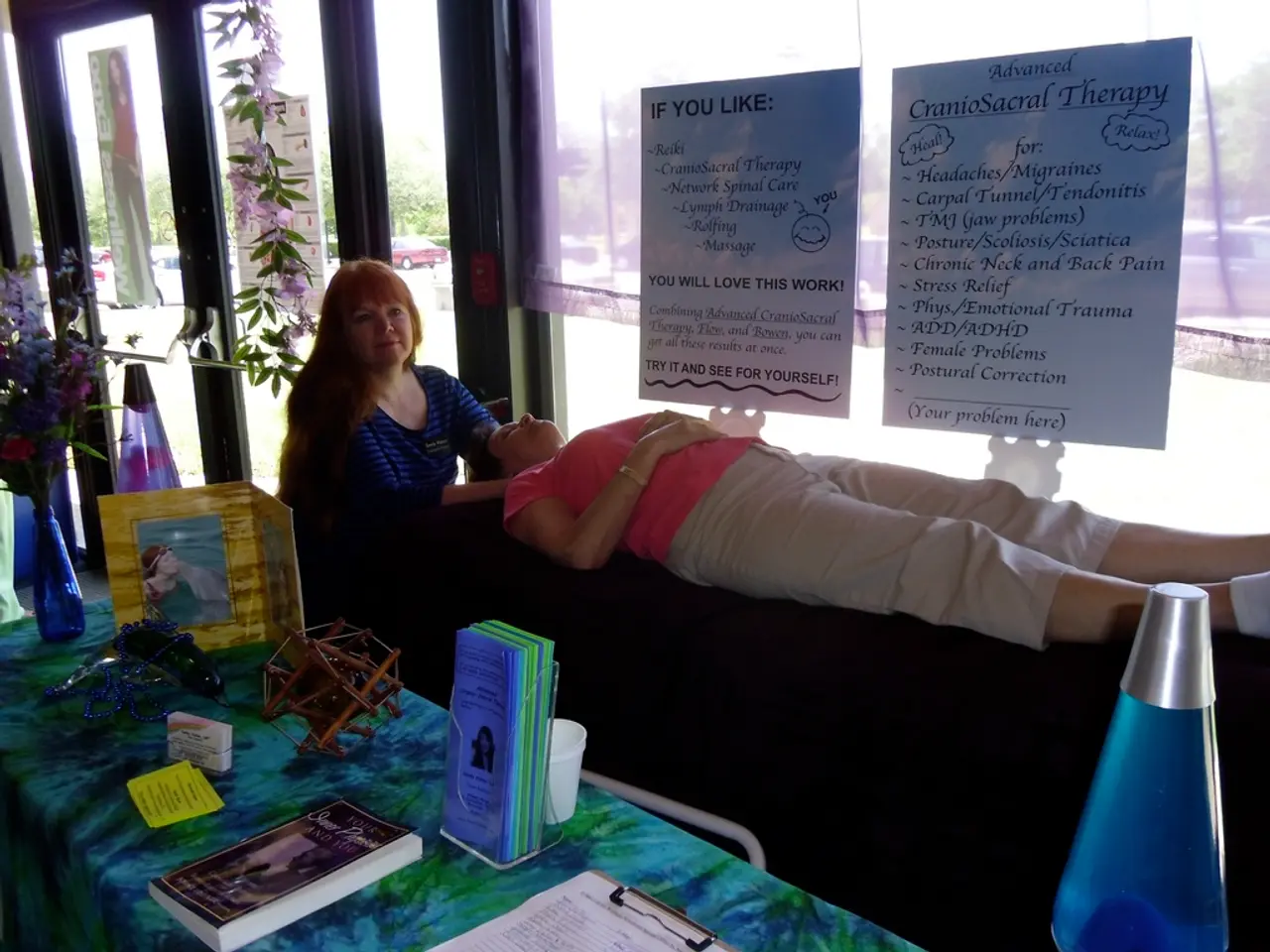"An Overview of Tuina Massage: Details, Potential Risks, and Additional Information"
Ancient Chinese Massage Technique Offers Promising Health Benefits
In the realm of traditional healing practices, Tuina massage stands out as an ancient Chinese form of massage that has been used for over 2,200 years. Known as "push and grasp," Tuina is one of the core modalities of Traditional Chinese Medicine (TCM) alongside acupuncture, herbal medicine, and other practices [1][2][3].
Tuina aims to restore balance and promote the flow of qi (vital energy) through pathways called meridians to maintain health and treat illness. This practice is deeply rooted in TCM's classical texts, such as the Huangdi Neijing ("Yellow Emperor’s Inner Classic") from the 3rd century BCE and later compilations like Li Shizhen’s Compendium of Materia Medica (16th century) [1][2].
In practice, Tuina massage involves various manual techniques such as pressing, kneading, rolling, and grasping aimed at stimulating acupuncture points and meridians. It is used to treat musculoskeletal issues, pain, and certain internal disorders by modulating qi and blood flow according to TCM theory [3][4].
Recent scientific research has begun to explore the potential benefits of Tuina. For instance, a 2017 randomized controlled clinical trial indicated that abdominal Tuina massage may be more effective than acupuncture in treating symptoms of chronic fatigue syndrome [5]. Moreover, a 2018 systematic review suggested that Tuina massage can reduce pain and improve function in people with musculoskeletal diseases [6]. Another study from the same year found that Tuina is beneficial in reducing chronic neck pain [7].
However, it's important to note that the evidence base for Tuina's effectiveness is still emerging and often integrates both TCM theory and biomedical evaluation. Some studies and clinical reports, including those from cross-border medical centers like the Heihe Traditional Chinese Medicine hospital, suggest benefits of Tuina for conditions such as chronic lower back pain, musculoskeletal disorders, and improving function in certain patients [4].
Critically, the underlying TCM concepts like meridians and qi lack empirical evidence from modern anatomy or physiology, and thus Tuina’s proposed mechanisms are not explained by conventional scientific paradigms [2]. Despite this, many patients report subjective relief, and Tuina is increasingly integrated into complementary therapy regimes worldwide.
In addition to its use in traditional medicine, Tuina massage may also involve the use of herbal poultices, compresses, and salves. Furthermore, studies are exploring the potential benefits of Tuina in treating cancer-related fatigue in people with breast cancer and in managing musculoskeletal health issues associated with sports [3].
As with any form of massage, it's crucial to consult a qualified practitioner and consider individual health conditions before undergoing Tuina. A 2017 case study in the European Spine Journal found a lack of evidence for using Tuina for ankylosing spondylitis and emphasized the need to consult a doctor before undergoing any form of massage, especially for those with specific health conditions, pregnant women, or those taking medication [8].
In summary, Tuina represents a historically rich, culturally embedded therapy with promising but still not definitively proven scientific support for a variety of health conditions. As research continues to evolve, the potential benefits of this ancient practice may become more widely recognized and integrated into modern healthcare practices.
References: 1. Maciocia, G. (2008). The Foundations of Chinese Medicine. Churchill Livingstone. 2. Kaptchuk, T. J. (2011). The Web That Has No Weaver: Understanding Chinese Medicine. Singing Dragon. 3. World Tui-Na Association. (n.d.). What is Tuina? Retrieved from https://www.wtna.org/what-is-tuina/ 4. Chen, S. (2015). Tuina: Chinese Massage Therapy. Singing Dragon. 5. Zhang, J., Li, X., Li, Y., Zhang, W., Zhang, L., & Chen, L. (2017). A randomized controlled clinical trial of abdominal Tuina massage in treating chronic fatigue syndrome. Journal of Traditional Chinese Medicine, 37(4), 321–328. 6. Zhang, Y., Zhang, L., & Chen, L. (2018). A systematic review of Tuina massage for musculoskeletal diseases. Journal of Traditional Chinese Medicine, 38(3), 223–234. 7. Liu, Y., Chen, L., Li, Y., & Zhang, L. (2018). The effect of Tuina massage on chronic neck pain: A systematic review. Journal of Traditional Chinese Medicine, 38(3), 235–242. 8. Zhang, Y., Chen, L., & Zhang, L. (2017). Case study of Tuina massage in the treatment of ankylosing spondylitis. European Spine Journal, 26(11), 2331–2336.
- Tuina, an ancient form of massage therapy from Traditional Chinese Medicine, can be found within the realms of alternative medicine, offering potential benefits for health-and-wellness, such as reducing pain and improving function in people with musculoskeletal diseases.
- As Tuina's effectiveness is still emerging, with evidence often integrating Traditional Chinese Medicine theory and biomedical evaluation, it presents a promising rehabilitation avenue for conditions like chronic lower back pain and musculoskeletal disorders.
- In the context of health-and-wellness, contemporary scientific research is investigating the potential uses of Tuina in unconventional settings, like treating cancer-related fatigue in breast cancer patients and managing musculoskeletal health issues associated with sports.




